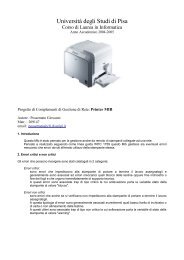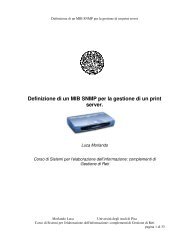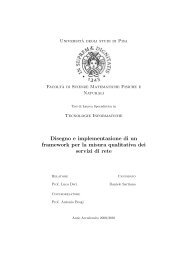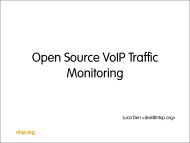vPF_RING: Towards Wire-Speed Network ... - Luca Deri - Ntop
vPF_RING: Towards Wire-Speed Network ... - Luca Deri - Ntop
vPF_RING: Towards Wire-Speed Network ... - Luca Deri - Ntop
You also want an ePaper? Increase the reach of your titles
YUMPU automatically turns print PDFs into web optimized ePapers that Google loves.
the hypervisor to virtualize the underlying hardware. In<br />
other words, the guest uses custom drivers that use a direct<br />
path for communicating with the hypervisor. Taking the<br />
example of VirtIO-Net [4], the paravirtualized network<br />
device in KVM, the burden on the hypervisor is reduced,<br />
and some optimizations, such as the VHost-Net support,<br />
attempt to reduce the number of system calls thus<br />
improving latency. Unfortunately the packet journey is not<br />
reduced as packets flow through virtual bridges and virtual<br />
TAP devices, and twice through the operating system.<br />
Recently, network equipments manufactures have<br />
introduced technologies for enhancing networking on<br />
virtualized environments. For example, some Intel server<br />
class network interface cards (NICs) implement the Intel<br />
VMDq (Virtual Machine Device Queues) technology [8].<br />
To abstract the network device and share it across multiple<br />
VMs, the hypervisor has to implement a software network<br />
switch, which usually introduce severe performance<br />
penalties. As shown in Figure 2, VMDq-aware NICs<br />
implement all this in hardware thus preventing the insoftware<br />
switching overhead. By combining this<br />
technology with optimized paravirtualization techniques, it<br />
is possible to achieve high networking performance in VMs<br />
[9] [10]. Unfortunately packet capture cannot benefit from<br />
it, as VMDq basically partitions the NIC into several<br />
virtual NICs but it does not feature mechanisms for:<br />
• Accelerating packet capture.<br />
• Capturing packets from all virtual queues, rather than<br />
from just the one assigned to the VM.<br />
VM1 VM2<br />
VM3 VMn<br />
L2 Software Switch<br />
L2 Hardware Classifier/Sorter<br />
<strong>Network</strong><br />
Hypervisor<br />
VMDq Enabled NIC<br />
Figure 2. Intel VMDq Technology<br />
Along the path of VMDq, the Single Root I/O<br />
Virtualization technology [11] is a way of sharing a device<br />
in a virtualized environment, bypassing the hypervisor<br />
involvement in data movement. As depicted in Figure 3,<br />
with this technology a single Ethernet port can be<br />
configured by the hypervisor to appear as multiple<br />
independent devices, each one with its own configuration<br />
space. The hypervisor assigns each Virtual Function (VF,<br />
lightweight PCIe functions) to a VM, providing<br />
independent memory space and DMA streams. PCIe PF<br />
(Physical Functions) is the physical device seen by the<br />
hypervisor on the host. Memory address translation<br />
technologies based on IOMMUs [12] [13], such as Intel<br />
VT-d [14] and AMD IOMMU, provide hardware assisted<br />
techniques to allow direct DMA transfers bypassing the<br />
hypervisor, while keeping isolation between host and VMs<br />
[30]. There are several projects following the same<br />
approach of the SR-IOV, with different designs of selfvirtualized<br />
devices for direct I/O [15] [16] [17]. All these<br />
techniques represent good solutions for common<br />
connectivity but, besides efficiency, they do not provide<br />
assistance in accelerating packet capture.<br />
VM1<br />
NIC driver<br />
NIC driver<br />
VM2<br />
NIC driver<br />
L2 Software Switch<br />
Hypervisor<br />
PCIe PF PCIe VF1 PCIe VFn<br />
Internet<br />
SR-IOV Enabled NIC<br />
2.2 Packet Filtering<br />
The previous section has shown various alternatives to<br />
implement efficient networking inside VMs. With<br />
paravirtualization, packets pass through virtual bridges and<br />
virtual TAP devices if hardware support such as VMDq is<br />
not present. Using VMDq-aware network devices or selfvirtualized<br />
devices [11] [15] [16] [17], packet filtering still<br />
happens in software as hardware filtering used by VMDq<br />
usually provides only MAC-address filtering and thus in-<br />
NIC bridging that is disabled when the NIC is set in<br />
promiscuous mode. The result is that both with/without<br />
VMDq, packet filtering has to happen in software as<br />
modern NICs do not provide assistance for filtering packets<br />
when used in virtualized environments.<br />
Early packet filtering is necessary to prevent packets from<br />
being discarded late in their journey to the VM, after that<br />
they have passed through several components. This is<br />
because filtering on guest OS means that the packet has<br />
already reached the VM and thus that in case of packet not<br />
satisfying any filter it would result in wasted CPU cycles.<br />
Another side effect of in-VM filtering, is that all received<br />
packets need to be copied to each VM, whereas in case of<br />
early filtering, just the packets matching the filters will be<br />
forwarded to VMs.<br />
For specific application domains such as lawful<br />
interception, filtering at the VM level represents a major<br />
performance issue. This is because network operators<br />
VM3<br />
NIC driver<br />
VMm<br />
NIC driver<br />
Figure 3. SR-IOV Technology






